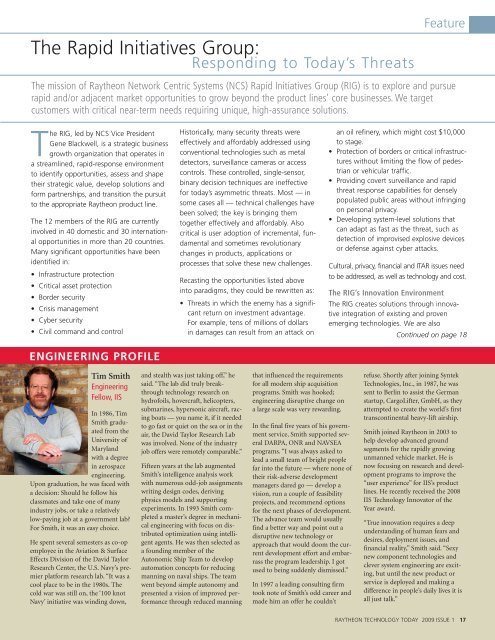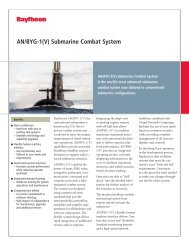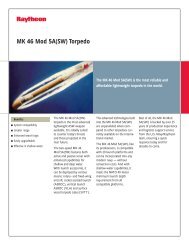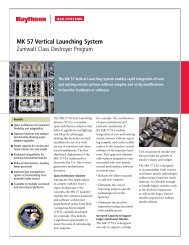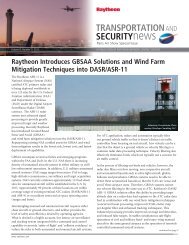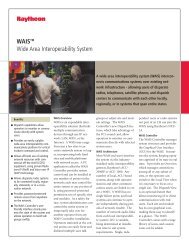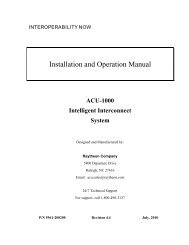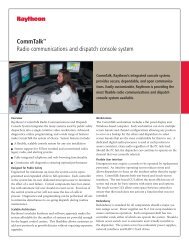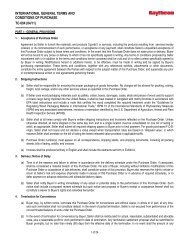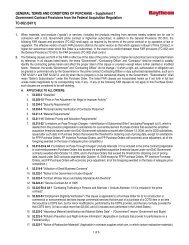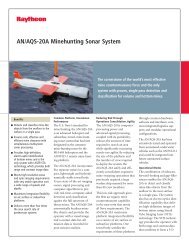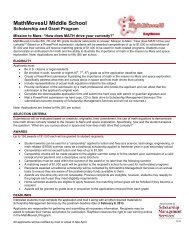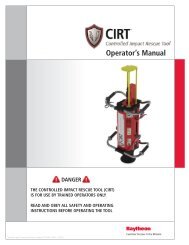Tech_Issue 1 2009_0127_Final:TechToday_012709 ... - Raytheon
Tech_Issue 1 2009_0127_Final:TechToday_012709 ... - Raytheon
Tech_Issue 1 2009_0127_Final:TechToday_012709 ... - Raytheon
You also want an ePaper? Increase the reach of your titles
YUMPU automatically turns print PDFs into web optimized ePapers that Google loves.
The Rapid Initiatives Group:<br />
Responding to Today’s Threats<br />
The mission of <strong>Raytheon</strong> Network Centric Systems (NCS) Rapid Initiatives Group (RIG) is to explore and pursue<br />
rapid and/or adjacent market opportunities to grow beyond the product lines’ core businesses. We target<br />
customers with critical near-term needs requiring unique, high-assurance solutions.<br />
The RIG, led by NCS Vice President<br />
Gene Blackwell, is a strategic business<br />
growth organization that operates in<br />
a streamlined, rapid-response environment<br />
to identify opportunities, assess and shape<br />
their strategic value, develop solutions and<br />
form partnerships, and transition the pursuit<br />
to the appropriate <strong>Raytheon</strong> product line.<br />
The 12 members of the RIG are currently<br />
involved in 40 domestic and 30 international<br />
opportunities in more than 20 countries.<br />
Many significant opportunities have been<br />
identified in:<br />
Infrastructure protection<br />
Critical asset protection<br />
Border security<br />
Crisis management<br />
Cyber security<br />
Civil command and control<br />
ENGINEERING PROFILE<br />
Tim Smith<br />
Engineering<br />
Fellow, IIS<br />
In 1986, Tim<br />
Smith graduated<br />
from the<br />
University of<br />
Maryland<br />
with a degree<br />
in aerospace<br />
engineering.<br />
Upon graduation, he was faced with<br />
a decision: Should he follow his<br />
classmates and take one of many<br />
industry jobs, or take a relatively<br />
low-paying job at a government lab?<br />
For Smith, it was an easy choice.<br />
He spent several semesters as co-op<br />
employee in the Aviation & Surface<br />
Effects Division of the David Taylor<br />
Research Center, the U.S. Navy’s premier<br />
platform research lab. “It was a<br />
cool place to be in the 1980s. The<br />
cold war was still on, the ‘100 knot<br />
Navy’ initiative was winding down,<br />
Historically, many security threats were<br />
effectively and affordably addressed using<br />
conventional technologies such as metal<br />
detectors, surveillance cameras or access<br />
controls. These controlled, single-sensor,<br />
binary decision techniques are ineffective<br />
for today’s asymmetric threats. Most — in<br />
some cases all — technical challenges have<br />
been solved; the key is bringing them<br />
together effectively and affordably. Also<br />
critical is user adoption of incremental, fundamental<br />
and sometimes revolutionary<br />
changes in products, applications or<br />
processes that solve these new challenges.<br />
Recasting the opportunities listed above<br />
into paradigms, they could be rewritten as:<br />
Threats in which the enemy has a significant<br />
return on investment advantage.<br />
For example, tens of millions of dollars<br />
in damages can result from an attack on<br />
and stealth was just taking off,” he<br />
said. “The lab did truly breakthrough<br />
technology research on<br />
hydrofoils, hovercraft, helicopters,<br />
submarines, hypersonic aircraft, racing<br />
boats — you name it, if it needed<br />
to go fast or quiet on the sea or in the<br />
air, the David Taylor Research Lab<br />
was involved. None of the industry<br />
job offers were remotely comparable.”<br />
Fifteen years at the lab augmented<br />
Smith’s intelligence analysis work<br />
with numerous odd-job assignments<br />
writing design codes, deriving<br />
physics models and supporting<br />
experiments. In 1993 Smith completed<br />
a master’s degree in mechanical<br />
engineering with focus on distributed<br />
optimization using intelligent<br />
agents. He was then selected as<br />
a founding member of the<br />
Autonomic Ship Team to develop<br />
automation concepts for reducing<br />
manning on naval ships. The team<br />
went beyond simple autonomy and<br />
presented a vision of improved performance<br />
through reduced manning<br />
that influenced the requirements<br />
for all modern ship acquisition<br />
programs. Smith was hooked;<br />
engineering disruptive change on<br />
a large scale was very rewarding.<br />
In the final five years of his government<br />
service, Smith supported several<br />
DARPA, ONR and NAVSEA<br />
programs. “I was always asked to<br />
lead a small team of bright people<br />
far into the future — where none of<br />
their risk-adverse development<br />
managers dared go — develop a<br />
vision, run a couple of feasibility<br />
projects, and recommend options<br />
for the next phases of development.<br />
The advance team would usually<br />
find a better way and point out a<br />
disruptive new technology or<br />
approach that would doom the current<br />
development effort and embarrass<br />
the program leadership. I got<br />
used to being suddenly dismissed.”<br />
In 1997 a leading consulting firm<br />
took note of Smith’s odd career and<br />
made him an offer he couldn’t<br />
Feature<br />
an oil refinery, which might cost $10,000<br />
to stage.<br />
Protection of borders or critical infrastructures<br />
without limiting the flow of pedestrian<br />
or vehicular traffic.<br />
Providing covert surveillance and rapid<br />
threat response capabilities for densely<br />
populated public areas without infringing<br />
on personal privacy.<br />
Developing system-level solutions that<br />
can adapt as fast as the threat, such as<br />
detection of improvised explosive devices<br />
or defense against cyber attacks.<br />
Cultural, privacy, financial and ITAR issues need<br />
to be addressed, as well as technology and cost.<br />
The RIG’s Innovation Environment<br />
The RIG creates solutions through innovative<br />
integration of existing and proven<br />
emerging technologies. We are also<br />
Continued on page 18<br />
refuse. Shortly after joining Syntek<br />
<strong>Tech</strong>nologies, Inc., in 1987, he was<br />
sent to Berlin to assist the German<br />
startup, CargoLifter, GmbH, as they<br />
attempted to create the world’s first<br />
transcontinental heavy-lift airship.<br />
Smith joined <strong>Raytheon</strong> in 2003 to<br />
help develop advanced ground<br />
segments for the rapidly growing<br />
unmanned vehicle market. He is<br />
now focusing on research and development<br />
programs to improve the<br />
“user experience” for IIS’s product<br />
lines. He recently received the 2008<br />
IIS <strong>Tech</strong>nology Innovator of the<br />
Year award.<br />
“True innovation requires a deep<br />
understanding of human fears and<br />
desires, deployment issues, and<br />
financial reality,” Smith said. “Sexy<br />
new component technologies and<br />
clever system engineering are exciting,<br />
but until the new product or<br />
service is deployed and making a<br />
difference in people’s daily lives it is<br />
all just talk.”<br />
RAYTHEON TECHNOLOGY TODAY <strong>2009</strong> ISSUE 1 17


